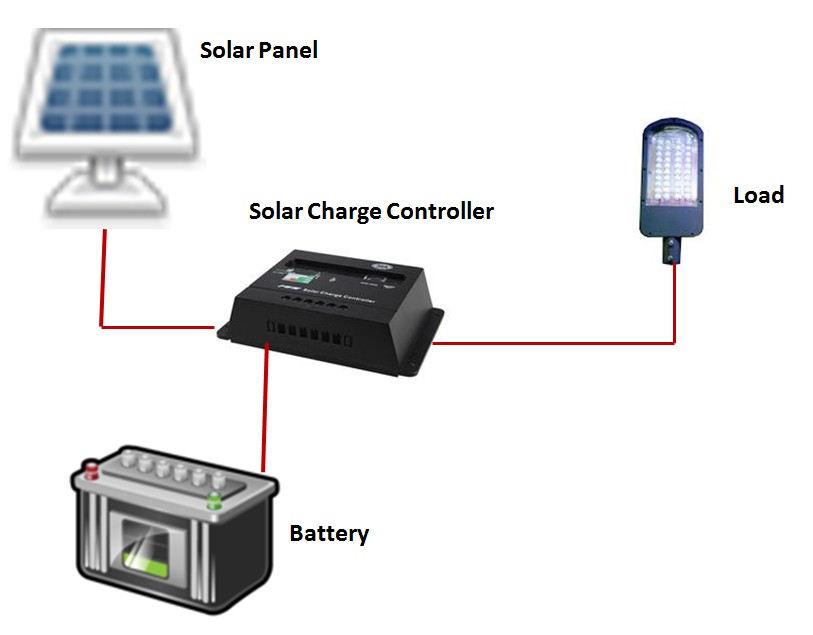Planning to buy a solar inverter & battery? Well, hold on! Do you know that you can convert your existing inverter & battery into a solar inverter & battery? Yes, you read it right. If you are buying a new inverter for your house or apartment then it is a smart choice to go for a solar inverter – it will work like a normal inverter and will also help you save money by using solar energy.
However, if you already have an inverter in your house then you can still make it into a solar power system by doing this simple thing. Add Solar Panels and Solar Charge Controller to Any Inverter-Battery setup and Your Home Solar System is ready!
Page Contents
Requirements for solar system installation
- Solar Panels for generating solar energy.
- Batteries for storing the energy.
- Solar Charge Controller for delivering right amount of charge to the battery and ensuring that current never flows from batteries to the panel.
- Inverter for converting DC power (generated by solar panels) into AC power and power all connected electrical load.
Also Read: Number Of Solar Panels, Battery Bank & Inverter Load You Need For Your Home
A solar power conditioning unit (PCU) and solar inverters have an in-built solar charge controller but if you are using an ordinary inverter then you have to install a solar charge controller to it.
What does solar charge controller do?

A Solar charge controller is very important because it regulates the amount of charge delivered to batteries. If there was no solar charge controller and the solar energy made by panels was getting directly to the batteries then that could result in bursting of batteries or premature failure of batteries. You must have read in papers that owing to the excess charge given to batteries by cheap and bad quality controllers cost lives as the battery burst.
Another important function of a solar charge controller is to maintain the flow of current in one direction only i.e. from solar panels to batteries. Otherwise, during nighttime, the charge could flow in opposite direction from batteries to panels which could ruin your costly panels.
Also Read: 4 Reasons Why Pure Sine Wave Inverters Are The Best
Making solar system using standard inverter & battery
The size of solar panels should be calculated keeping in mind the power of the inverter, connected battery capacity and load. In this case, we have an inverter of almost 1000 Watts so our solar panels should also be of 1000 Watts provided battery capacity is sufficient to accept the charge within safe limits. We can install 4 solar panels of 250w in parallel and/or series configurations depending on the inverter’s DC bus ratings (12V or 24V or higher).
The capacity of the solar charge controller should depend on the size of the battery and the current generated by solar panels.
Below are some examples of the typical solar systems configurations:
| Standard Products | Tubular Battery Bank Capacity & Configurations | Solar Charge Controller Ratings | Solar Panels capacity and configurations |
|---|---|---|---|
| 600-900VA/500W-12V | 150Ah | 12V/20A | 300Wp (2p*36 Cells 150Wp) |
| 600-900VA/500W-12V | 2p*150Ah (2 Parallel – 12V 300Ah battery bank) | 12V/30A | 500Wp (4p*36 Cells 125Wp) |
| 1250-1600VA/1000W-24V | 2s*150Ah (2 Series – 24V 150Ah Battery bank) | 24V/20A | 600Wp (2p*2s*36 Cells 150Wp) |
| 1250-1600VA/1000W-24V | 2p*2s*150Ah (2 Series and 2 Parallel – 24V 300Ah battery bank) | 24V/30A | 1000Wp (4p*60/72 Cells 250Wp) |
How will this solar power system work?
As the sun shines, panels make DC electricity which will be stored in batteries. When your batteries get fully charged you will have to switch off your main power supply. If you have a solar charge controller, this will be done automatically. As you do that the inverter will detect a power cut and will automatically start working.
You will be running all connected electrical appliances such as fans, lights, computers, coolers, etc. through your inverter. Don’t forget that your inverter is using the FREE and green solar energy stored in the batteries!
When the batteries get drained up to a defined limit, you will have to switch the main power supply back so that they can get charged through solar again.
When sunlight is absent, your inverter will charge the batteries like it normally does. Simple, isn’t it?
So, what did you learn today?
If you already have an ordinary inverter & battery, convert them into solar inverter & battery and save yourself some money.
If you don’t want to convert your existing inverter and battery into a solar inverter and battery, instead, wants to purchase a new solar inverter, then do check out these 6 things you must know about solar inverters.
Also Read: 3 Most Common Myths About Pure Sine Wave Inverters
Related Articles
- Livguard Inverter Battery Review
- What Is An Inverter? & How Does An Inverter Work?
- What Is Hybrid Solar Inverter? And How Does It Work?
Got Queries? Ask with #SolarClap
